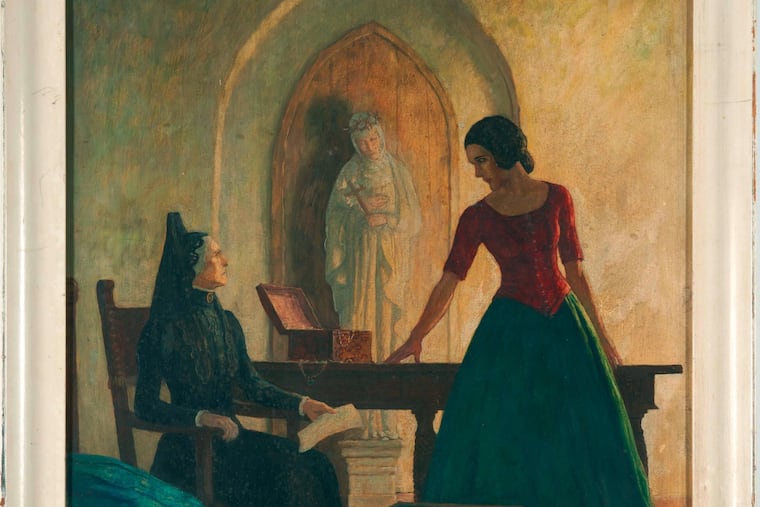She bought a painting for $4 at a thrift shop. Today, the N.C. Wyeth work sold for $191,000.
The painting has been identified as Ramona, a long-lost frontispiece illustration that was part of a four-work set by the premier 20th century illustrator and father of artist Andrew Wyeth.

You never know what you’re going to find in a thrift store bin.
Take the woman who was strolling through the Savers store in Manchester, N.H., about six years ago. A painting caught her eye: two women, one a stern elder and the other a maiden. She decided to buy it — either for $4 or $4.99, depending on the source. And that was that.
Until fairly recently. Some things about the painting apparently raised her curiosity, and she posted it on Facebook. Someone who knew a lot more about art than our bargain hunter saw the post. And one thing led to another.
On Tuesday, that painting of the two women sold for $191,000 at auction by Bonhams Skinner. It has been identified as Ramona, a long-lost frontispiece illustration that was part of a four-work set by N.C. Wyeth, a premier 20th-century illustrator and father of the artist Andrew Wyeth. The seller has requested to remain anonymous, but, according to information from Bonhams, Ramona was one of four illustrations Wyeth contributed to the 1939 edition of Helen Hunt Jackson’s novel of the same name.
» READ MORE: Betsy Wyeth: The woman who ‘created the worlds’ captured on canvas by her husband.
“This work was likely gifted by the publishers to an editor or the author’s estate, but its location was unknown until it was found by chance in a New Hampshire antique shop by the owner,” according to a statement by Bonhams.
The woman who had unknowingly purchased the valuable painting at Savers “will get most of the hammer price with Bonhams Skinner receiving a small percentage,” said auction house spokesperson Sheri Middleton.
The name of Tuesday’s buyer was not disclosed. The Brandywine Museum of Art, renowned for its Wyeth collection, opted not to bid.
None of this auction action would have happened if the thrifter’s Facebook post wasn’t noticed by Lauren Lewis, a Maine-based conservator, who recognized the painting and arranged to examine it in person.
She then consulted with Christine Podmaniczky, curator emerita, N.C. Wyeth Catalogue Raisonne, at the Brandywine, who agreed it was in fact the missing Ramona.
Accounts of the find were published in various media, including ARTnews, the Smithsonian, and the New York Times.
In Podmaniczky’s statement on findings provided by the Brandywine, she said that by 1939, Wyeth prepared most of his commercial work by first doing a detailed charcoal drawing of his composition. He would then have that professionally photographed and produced as a lantern slide. The whereabouts of the original drawing are unknown, but Podmaniczky wrote that the lantern slide for Ramona was found in his Chadds Ford studio. It is now in the Brandywine’s collection archives.
The maroon backing of the painting offered more clues.
“At this point in his career, Wyeth preferred to paint on ‘renaissance panels,’ composite board commercially prepared by the F. Weber Co. in Philadelphia, recognized by the deep maroon color of the reverse side and the ornate label applied to it,” wrote the N.C. Wyeth expert.
That description fits the back of the bargain Ramona to a T.
Wyeth’s home and studio, a National Historic Landmark owned and overseen by the Brandywine Museum, is available for tours.
In case you’re wondering, the anonymous shopper also made a killing over what the Treasure Island artist earned for his set of illustrations that included Ramona.
According to Podmaniczky’s statement, Wyeth’s income tax notes for 1939 say he was paid $1,000 for the whole set — about $22,000 in today’s dollars.
Up in New Hampshire, Savers store manager Shaun Edson said on Tuesday that they have no idea who brought in their now-famous sold item. He thought the actual sale price was $4.99, but had no record.
“From what I understand, that painting was donated through our donation center and then made its way out to the floor,” he said. “Our donations are done anonymously.”
But as random as the anonymous shopper’s good fortune might seem, that’s not keeping others from hoping to get lucky.
Said the manager: “There’s definitely more people going through the art section of the store.”